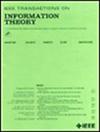Grouping-Based Cyclic Scheduling Under Age of Correlated Information Constraints
IF 2.2
3区 计算机科学
Q3 COMPUTER SCIENCE, INFORMATION SYSTEMS
引用次数: 0
Abstract
This paper studies an internet of things (IoT) network where a fusion center relies on multi-view and correlated information generated by multiple sources to monitor various regions. Each region possesses hard age of correlated information (AoCI) constraints for information update, and accordingly we propose a scheduling policy to satisfy such needs and minimize the required wireless resources. We first approximate the problem to a dual bin-packing problem. Secondly, efficient scheduling policies are identified when the age constraints possess special mathematical properties, where the number of channels at most required is analyzed. Optimality conditions of the proposed policies are presented. For general constraints, a two-step grouping algorithm for multi-view (TGAM) is proposed to establish scheduling policies. Under TGAM, the constraints are mapped into a combination of the special constraints. To quickly identify an optimized mapping from a vast solution space, TGAM heuristically groups the regions according to their constraints and then searches for the optimal mapping for each group. Numerical results demonstrate that, compared to a derived lower bound, the proposed TGAM requires only 1.07% more channels. Additionally, the number of regions that can be served by TGAM is significantly larger than the state-of-the art algorithm, given the number of channels.求助全文
约1分钟内获得全文
求助全文
来源期刊

IEEE Transactions on Information Theory
工程技术-工程:电子与电气
CiteScore
5.70
自引率
20.00%
发文量
514
审稿时长
12 months
期刊介绍:
The IEEE Transactions on Information Theory is a journal that publishes theoretical and experimental papers concerned with the transmission, processing, and utilization of information. The boundaries of acceptable subject matter are intentionally not sharply delimited. Rather, it is hoped that as the focus of research activity changes, a flexible policy will permit this Transactions to follow suit. Current appropriate topics are best reflected by recent Tables of Contents; they are summarized in the titles of editorial areas that appear on the inside front cover.
 求助内容:
求助内容: 应助结果提醒方式:
应助结果提醒方式:


